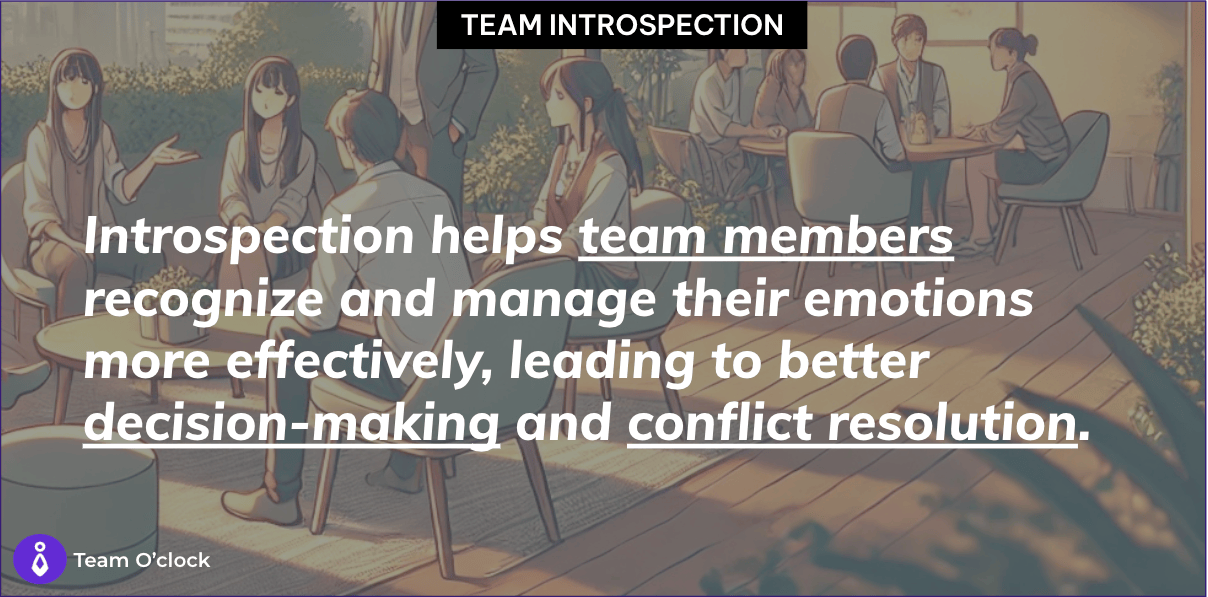
The True Essence of Agile: How Introspection Fuels Growth

Ever wondered which is the secret weapon of high-performing Agile teams? Hint: it’s not their streamlined process. I’ll spare you the guesswork and get straight to it. The correct answer is in their profound ability to introspect. Introspection is a true power that Agile teams can wield to maintain a competitive edge. By consistently looking inward and assessing their practices, Agile teams can uncover insights that drive continuous improvement and innovation.
Research shows that teams who engage in regular introspection see up to a 20% increase in productivity and a 25% improvement in team morale. This powerful tool enables teams to adapt quickly, overcome challenges efficiently, and harness their collective strengths more effectively.
In this blog, you will realize introspection's critical role in Agile success, dive into actionable strategies for applying this powerful practice to your team’s routine, and identify potential barriers you must be aware of.
What Are The Current Demands of Agile Teams?
1. Rapid Technological Changes
The pace of technological advancement shows no signs of slowing down. Emerging technologies such as artificial intelligence, blockchain, and the Internet of Things continuously reshape development.
Agile teams must stay ahead by embracing a culture of constant learning, experimentation, and adaptability. This requires keeping up with new tools and methodologies and being open to rethinking and reworking existing processes to leverage these advancements fully.
2. Customer Expectations
Customers today expect faster, high-quality deliveries and a commitment to continuous improvement. Agile teams are constantly pressured to deliver functional, user-centric products in shorter timeframes.
Meeting these heightened expectations requires an iterative approach that prioritizes customer feedback and integrates it promptly into development cycles. Introspection helps teams align their outputs more closely with customer needs, enhancing satisfaction and loyalty.
3. Competitive Market
The software market is more competitive than ever. Companies need to innovate rapidly and adapt quickly to remain relevant and efficient. Agile practices provide a framework for this, but without regular introspection, teams can become complacent and miss opportunities for improvement. By regularly reflecting on their performance and processes, Agile teams can identify areas for innovation and stay agile, even in highly competitive environments.
4. Remote Work Dynamics
The shift towards remote and distributed teams presents both challenges and opportunities. While remote work can increase flexibility and access to a global talent pool, it also requires new communication and collaboration strategies.
Introspection becomes a no-brainer in this context.
How?
By helping teams:
navigate the dynamics of remote work,
build stronger virtual connections, and
maintain high levels of productivity and engagement.
What is Introspection in the Agile Environment?
Introspection in the Agile environment refers to the process of self-examination and reflection within the team. It involves regularly assessing what is working well, what is not, and how the team can improve. This process is integral to the Agile philosophy of continuous improvement and adaptability.
What Are the Key Introspection Practices for Agile Teams?
Critical introspection practices for Agile teams involve regularly reflecting on their work, processes, and interactions to identify areas for improvement and celebrate successes. These practices help teams continuously improve and adapt to changes. Here are some introspective practices for both in-house and remote Agile teams:
One-on-One Meetings
Team Health Checks
Root Cause Analysis (RCA)
Sprint Reviews
Personal Reflection Time
Peer Reviews and Pair Programming
Innovation and Experimentation Time
How Introspection Can Fuel Growth Within an Agile Team
1. Enhanced Self-Awareness
Introspection enhances self-awareness within Agile teams. Regularly examining their strengths and weaknesses, team members better understand their dynamics and individual contributions. This awareness fosters personal and collective growth, leading to more effective collaboration and higher performance.
2. Continuous Improvement
Introspection drives continuous improvement by providing a framework for teams to refine their processes, tools, and collaboration techniques iteratively. Regular reflection helps identify inefficiencies and implement changes that enhance productivity and quality.
3. Increased Innovation
Through introspection, Agile teams can foster a culture of creative problem-solving and out-of-the-box thinking. Reflecting on past successes and failures provides valuable insights that inspire innovative solutions and approaches.
4. Stronger Team Cohesion
Regular reflection and feedback sessions build trust and open communication within the team. This cohesion enhances collaboration, reduces misunderstandings, and creates a more supportive and productive work environment.
5. Improved Emotional Intelligence
Introspection helps team members recognize and manage their emotions more effectively, leading to better decision-making and conflict resolution. Enhanced emotional intelligence contributes to a more harmonious and resilient team dynamic.

6. Resilience
Reflecting on past challenges and successes strengthens the team's ability to navigate future obstacles. Introspection fosters resilience, helping teams stay motivated and focused on their growth journey.
5 Barriers to Implementing Introspective Techniques
1. Cultural Resistance
Overcoming organizational inertia and resistance to change is a significant barrier to implementing introspective techniques. Many organizations are accustomed to traditional hierarchical structures and may resist Agile practices' collaborative and reflective nature.
2. Lack of Time
Balancing introspection with delivery pressures and deadlines can be challenging. Teams may struggle to find the time for regular retrospectives and reflection periods amidst tight schedules and high workloads.
3. Insufficient Training and Lack of Facilitation Skills
Effectively facilitating introspective sessions requires specific skills that some team members may lack. Ensuring teams are equipped with the necessary skills and knowledge to conduct effective retrospectives is crucial for successful introspection.
4. Unclear Purpose
If the team does not understand the value of introspection or how it connects to their goals, they may not see it as a priority. Clearly communicating the purpose and benefits of introspection is vital to its successful implementation.
5. Fear of Feedback and Psychological Safety
A lack of trust or fear of criticism can prevent team members from sharing their honest thoughts and feelings during introspective sessions. Creating a psychologically safe environment where feedback is valued and encouraged is vital for productive introspection.
How Agile Teams Can Effectively Overcome These Barriers
1. Building a Growth Mindset
Encouraging a culture that values learning and continuous improvement is fundamental to overcoming resistance. Promoting a growth mindset helps teams embrace introspection as a tool for development and success.
2. Allocating Dedicated Time
Prioritizing regular retrospectives and reflection periods in the schedule ensures that introspection is not overlooked. Allocating dedicated time for these activities demonstrates their importance and integrates them into the team's workflow.
3. Training and Support
Educating team members on introspective techniques and facilitating effective retrospectives is essential. Offering training and resources helps them develop the skills needed to conduct productive introspection sessions.
4. Creating a Safe Space
Establishing a psychologically safe environment where team members feel comfortable sharing feedback is crucial. Encouraging open communication and trust helps overcome fear of criticism and fosters honest and constructive introspection.

5. Communicating the Purpose
Articulating the purpose and benefits of introspection helps teams understand and prioritize its value. Alignment and commitment are guaranteed when introspection is connected with the team's goals and objectives.
6. Leadership Buy-In
It is vital to secure leadership's commitment to support and champion introspective practices. Leadership buy-in reinforces the importance of introspection and provides the necessary resources and support for its successful implementation.
Takeaway
Introspection is a powerful tool for driving growth and effectiveness within Agile teams. By enhancing self-awareness, fostering continuous improvement, and building resilience, introspection enables teams to adapt and thrive in a dynamic tech landscape.
Overcoming barriers to introspection requires a concerted effort to foster a growth mindset, allocate dedicated time, provide training and support, create a safe space, clearly communicate the purpose, and secure leadership buy-in.
Embracing introspection improves team performance and fosters a culture of continuous growth and innovation, which is vital for success in today’s ever-changing tech landscape. Agile teams integrating introspective practices into their workflows are better positioned to meet the demands of rapid technological changes, heightened customer expectations, and competitive market pressures.
The journey towards true agility revolves around ongoing reflection, learning, and adaptation. Team O’Clock’s agile solutions are tailored to your team’s needs and designed to help you embrace the true essence of Agile.

More articles to check

Assist your team's growth with our partnership program:








